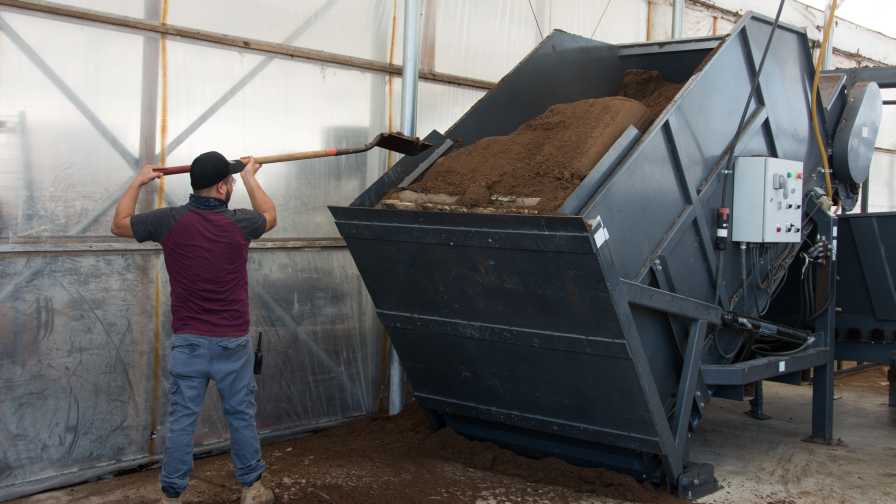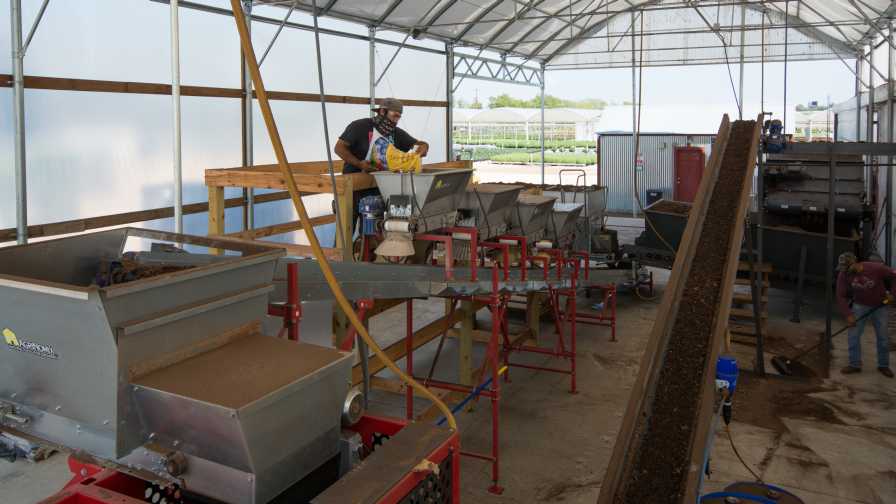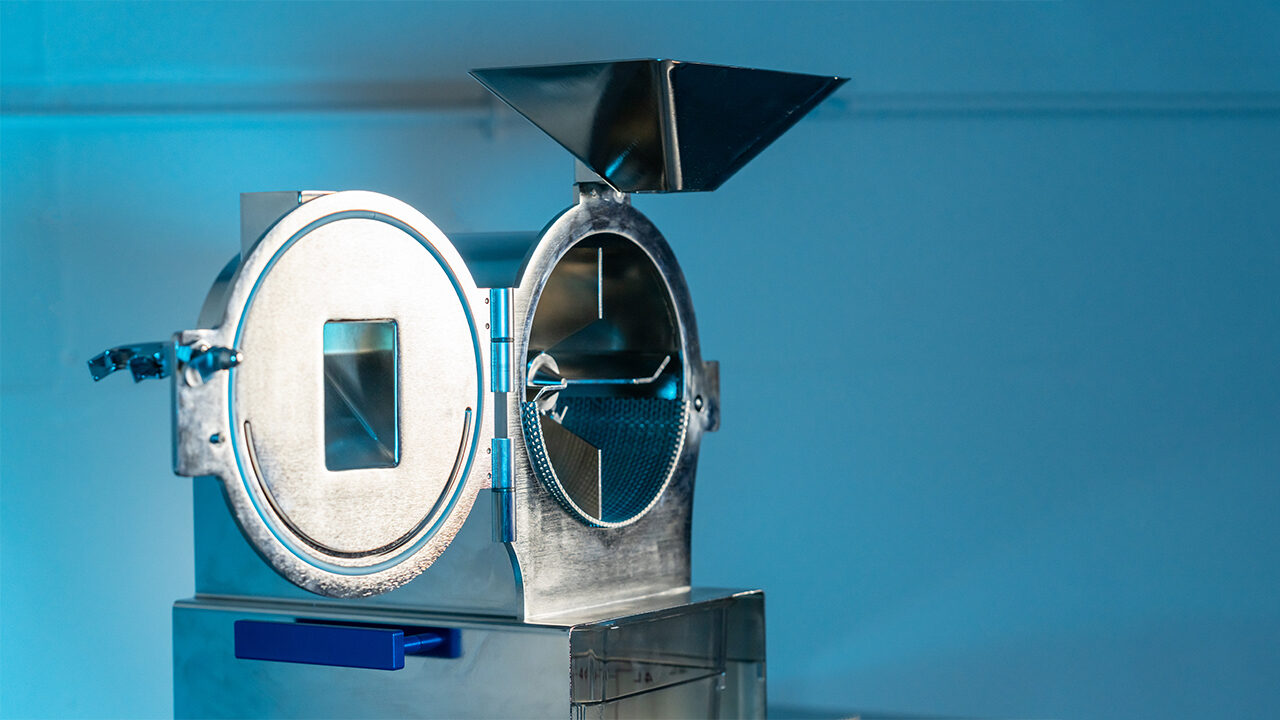Want to Mix Your Own Growing Media? Do the Homework

When Green Lake Nursery began mixing its own media, the Texas operation realized it had to add a bark bin for storage.
Photo by Rachel Harned, Green Lake Nursery
There seems to be more growers electing to make their own media mixes on site. This requires them to now be mix manufacturers and material handlers, not to mention blenders. With more products coming in compressed bales (for ease of shipping and on-site storage), the specialized equipment to reconstitute the materials and the process of blending offers a steep learning curve.
But there are ways to do this effectively. Keep reading for advice from one growing operation, as well as the supplier they worked with.
Facility Changes May Be Necessary
Austin Quimby, General Manager at Green Lake Nursery outside of Dallas, TX, says his team had been looking at options for bark-based mixes for some time.
“Premade mixes were either on the expensive side with composted bark and peat moss, or cheaper mixes containing mostly bark, compost, and sand,” Quimby says. “We started getting to the point where we could not expand our lineup based on the media involved.”
When it came time to update their mixing system, Quimby reached out to AgriNomix for advice. One big consideration was having the ability to incorporate fertilizer into Green Lake’s mixes.
“We were spending large numbers of man-hours applying granular fertilizer to certain crops,” Quimby says. “After looking at the cost of material savings, the ability to reduce hours, and the opportunity to expand our product mix and volume, we decided to move forward and mix our own.”
Quimby says his team had to change the area where it stores product, including adding a bark bin. It also had to revisit its maintenance schedule and plan for additional work to account for the upkeep of the new equipment.
“We also planned for the expansion of our production area to accommodate future needs,” Quimby says. “We have found that taller roofs make it much easier to operate machinery and service the lines. The equipment is housed in a 16-foot, gutter-height greenhouse to allow ample clearance.”
A new mix can be challenging to customers who may be familiar with old mixes, Quimby says. But overall, most people accepted it.
“Educating our customers on the benefit of the new mix has helped with the transition,” Quimby says.

Taller roofs make it easier to operate machinery and service mixing lines, which is why Green Lake Nursery houses its equipment in a 16-foot gutter-height greenhouse.
Photo by Rachel Harned, Green Lake Nursery
Step-By-Step Advice
As growers delve more into developing specialized blends on site, it is important to address the steps in the blending process, including material selection, equipment calibration, and other techniques that will help to assure the highest level of quality, consistency, and success.
Here are some guidelines and recommendations from the team at Profile Products, which manufactures HydraFiber engineered substrates.
Determine which raw materials you will use. Depending on what you choose, this will have a direct influence on water-holding capacity and airspace. Components will be variable because all the materials come from plants. The key is the process. The way the components are processed and how you handle them can influence your success. Consistency is critical, so make sure you buy from a supplier that has good quality control in place, and make sure you have good processes in place on site to evaluate and work with variable components.
Determine how much material you need and purchase the raw materials that have long lead times and need to be stored well in advance of use. Some raw materials require a long transit time, while others are readily available. Choosing a couple of raw materials helps limit your risk if a component is not available.
Develop your formulations and recipes ahead of time. Issues to consider as you develop your mixes include how many recipes you plan on making (generally, fewer recipes are better, and most crops can be grown in three or fewer recipes); the physical property targets for your recipes (airspace values should be between 15% to 25% for most ornamental crops, but generally most growers should err on the high side); and your water quality, which is critical to developing your lime rates for formulations, particularly your water alkalinity (not pH).
Finally, do preventative maintenance in between seasons and during downtime. It can help to prevent costly downtime during key production times of the year. Make sure not only the mix line and mixing area is ready to go, but also the container and pot-filling area.
Consider Pre-Mixed Options
Of course, there are also a large number of growers, especially medium-sized operations, meeting in the middle and purchasing pre-mixed substrates.
“Achieving high quality and consistency can be very difficult when blending on site, and many growers see this as a big challenge,” says Søren Møller Nielsen, Sales Director Americas at Pindstrup. “More raw materials are getting harder and more expensive to source, and availability can also be an issue at times depending on the season.”
A Note of Caution
When you are looking at cutting down on your production costs, producing your own growing media is very attractive, especially for large-scale growers. It certainly appears to have fewer implications than producing your own seeds, molding your own containers, or formulating your own pesticides. But it’s not that easy, and it’s important to evaluate the risks involved with making your own mix, according to Pierre-Marc de Champlain, Director-Technical Services at Berger. Many subtle yet substantial elements can be overlooked, leading to unforeseen, additional costs. The consequences can have significant repercussions on your bottom line, as the quality of the growing media will directly impact the timing of the growing cycle, water/fertilizer management, and the quality of the finished crop.
It is typically more feasible for larger operations to find success with mixing their own substrate, while smaller ones are better off using finished mixes, de Champlain says.
“A rudimentary mix line should include a bale breaker, large hoppers for each main component, smaller hoppers for the fertilizers, lime, and wetting agent, conveyors, and a soil mixer to blend everything homogenously,” de Champlain says. “You must also consider that a mix line will occupy a lot of real estate that could be used for other purposes. Moreover, you will need an experienced and knowledgeable staff to adjust the settings and perform maintenance on the equipment.”
There are advantages to making your own in-house mix, de Champlain says, such as the flexibility to adjust your substrate to meet the needs of a specific crop.
“However, I have seen growers having to re-transplant tens of thousands of plants and throw out hundreds of yards of substrate because the wrong recipe was prepared,” de Champlain says. “Corrective measures are typically labor intensive and can quickly become very expensive.”
The bottom line, de Champlain says, is that a good growing media manufacturer who provides high-quality, pre-mixed growing media can offer peace of mind and eliminate at least one of the many sources of stress that growers must deal with. This way, they can concentrate on growing and work on reducing costs by optimizing other aspects of production that pose less of a risk to their bottom line.









